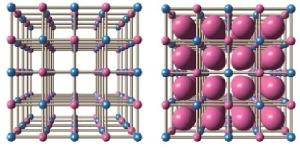Feb 19 2018
Scientists from the University of Tsukuba have developed a battery that operates based on differences in temperature and has the potential to recover background heat energy that is marginally above the ambient temperature.
 This is a crystal structure. (Image credit: University of Tsukuba)
This is a crystal structure. (Image credit: University of Tsukuba)
When energy is transformed from one form into another, a portion of the energy is lost as heat. Attempting to effectively retrieve that energy is highly challenging if it is lost to the environment. Thermoelectric devices have the ability to convert heat energy into electricity and in reverse. However, for effectively tapping energy from heat, these devices generally have to function at higher temperatures with a huge temperature difference.
At present, scientists from the University of Tsukuba in Japan have created an innovative type of thermoelectric system with the ability to tap minute energy differences at lower temperatures. Their outcomes have been recently published in the Applied Physics Express journal.
Thermoelectric batteries, like ours, have been proposed before but those have been based on liquid-based cells, which are impractical for real-world applications. We created a thin-film device that operates on the same principle but with two types of solid redox materials that produce a change in the potential difference in the cell over a heating and cooling cycle.
Takayuki Shibata, Lead Author
Modifying the temperature changes the potential of different layers inside the device to retain electrons. If one of the layers has more potential to retain the electrons than another layer, a potential difference is developed. The electron transfer from one of the layers to the other can then be exploited to perform work when the cell gets discharged, similar to the functioning of a normal battery.
The scientists investigated their devices for tapping waste heat energy close to ambient temperature. Their device generated 2.3 meV of electrical energy per heat cycle from about 25 °C and 50 °C. This outcome indicated an efficiency of nearly 1.0%, despite the fact that the theoretical maximum for this device must be nearly 8.7%.
We still have some work to do on improving the efficiency by we expect that these issues will be overcome by optimizing the anode and cathode materials. Importantly, we have shown that solid-state thermoelectric batteries are viable and our film deposition method could be extended to large areas. This technology offers realistic prospects for large-scale heat energy recovery, which could help a range of industries become more efficient.
Yutaka Moritomo, Corresponding Author